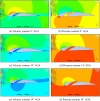Computational and experimental study on the aerodynamic performance of NACA 4412 airfoil with slot and groove
- PMID: 38845868
- PMCID: PMC11154210
- DOI: 10.1016/j.heliyon.2024.e31595
Computational and experimental study on the aerodynamic performance of NACA 4412 airfoil with slot and groove
Abstract
Since the Wright Brothers' first flight in 1903, extensive research has been dedicated to improving the aerodynamic performance of aircraft. This study investigates the effect of two distinct wing geometric modifications on airfoil performance at high angles of attack (AOAs). These two modifications are slot, specifically the NACA 4412 with only a slot, and groove, specifically the NACA 4412 with both a slot and a groove. The investigation combines numerical simulation using ANSYS fluent with experimental evaluations conducted in the VDAS AF1300 subsonic wind tunnel. Since turbulent airflow often results in early stall, the primary objective of this research is to delay the stall angle of the normal NACA 4412 airfoil by mitigating local separation zones, and boundary layer transitions. Numerical simulations are performed at airspeeds of 20 m/s and 43.9 m/s, while experimental investigations are conducted at a speed of 20 m/s. The results indicate that both modified airfoils have higher lift-to-drag ratio than the normal airfoil at high AOAs. Specifically, the NACA 4412 airfoil with only a slot demonstrates the highest lift-to-drag ratio among the modified airfoils at high AOAs. Moreover, the NACA 4412 airfoil equipped with a slot and a groove demonstrates the highest stall angle, measured at 18°, compared to the normal NACA 4412 airfoil with a stall angle of 14°. At high AOA, the NACA 4412 airfoil with a slot generates a nearly 35 % higher lift coefficient than the normal NACA 4412 airfoil, while the NACA 4412 with a slot and a groove achieves almost a 16 % higher lift coefficient than the normal NACA 4412 airfoil.
Keywords: Aerodynamics; Airfoil; CFD; Groove; NACA 4412; Slot.
© 2024 Published by Elsevier Ltd.
Conflict of interest statement
The authors declare that they have no known competing financial interests or personal relationships that could have appeared to influence the work reported in this paper.
Figures




















Similar articles
-
Multi-slotted airfoil design for enhanced aerodynamic performance and economic efficiency.Sci Rep. 2025 Feb 4;15(1):4290. doi: 10.1038/s41598-025-87000-z. Sci Rep. 2025. PMID: 39905159 Free PMC article.
-
Impact of double split slot geometry on aerodynamic performance of modified airfoil for wind turbine blades.Sci Rep. 2025 Aug 11;15(1):29315. doi: 10.1038/s41598-025-12174-5. Sci Rep. 2025. PMID: 40790313 Free PMC article.
-
Aerodynamic analysis and ANN-based optimization of NACA airfoils for enhanced UAV performance.Sci Rep. 2025 Apr 8;15(1):11998. doi: 10.1038/s41598-025-95848-4. Sci Rep. 2025. PMID: 40199959 Free PMC article.
-
Investigation of a bio-inspired lift-enhancing effector on a 2D airfoil.Bioinspir Biomim. 2012 Sep;7(3):036003. doi: 10.1088/1748-3182/7/3/036003. Epub 2012 Apr 12. Bioinspir Biomim. 2012. PMID: 22498691
-
Covert-inspired flaps for lift enhancement and stall mitigation.Bioinspir Biomim. 2021 Jun 22;16(4). doi: 10.1088/1748-3190/abf3b3. Bioinspir Biomim. 2021. PMID: 33784648
References
-
- Al-Jibory M.W., Shinan H.A.A. Numerical study of the boundary layer separation control on the NACA 0012 airfoil using triangular rib. IOP Conf. Ser. Mater. Sci. Eng. 2020;671 doi: 10.1088/1757-899X/671/1/012144. - DOI
-
- Mustak R., Uddin M., Mashud M. Proceedings of the 3rd International Conference on Mechanical Engineering and Renewable Energy. 2015. Effect of different shaped dimples on airfoils; pp. 26–29.
-
- Faruqui S.H.A., Bari Md A.A., Emran M., Ferdaus A. Numerical analysis of role of bumpy surface to control the flow separation of an airfoil. Procedia Eng. 2014;90:255–260. doi: 10.1016/j.proeng.2014.11.846. - DOI
-
- Merryisha S., Rajendran P. Experimental and CFD analysis of surface modifiers on aircraft wing: a review. CFD Lett. 2019;11(10):46–56.
-
- Houghton Capenter, Collicott S., Valentine . seventh ed. 2016. Aerodynamics for Engineering Students. 0081001940.
LinkOut - more resources
Full Text Sources
Miscellaneous

